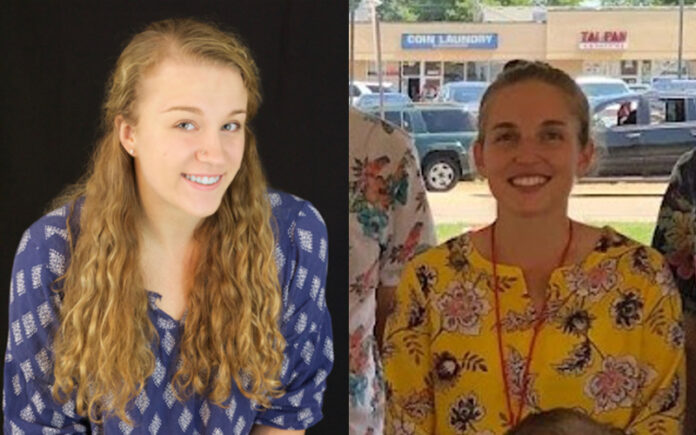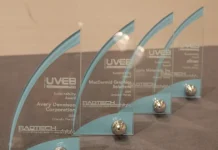The RadTech YP Committee, which aims to help young professionals (YPs) grow in the use and development of UV and EB technology, highlights Hunter Peczynski and Nicole Murley.
Hunter Peczynski is the lab manager at 7D Innovators and also attends Arizona State University for her BA in Chemistry. She is new to the UV/EB industry but has been using her background in dentistry to make advancements in medical 3D printing. During her weekends, she spends time with her fiancé and her two cats.
Nicole Murley is a product development chemist at Henkel Corporation, working on UV-curable sealing and gasketing technologies. Prior to joining Henkel in 2019, she was a high school math and science teacher. She is passionate about personal growth, supporting STEM education and networking with other professionals who share those passions.
RTYP: When did you first learn about UV/EB as an industry and technology?
HP: I first learned about it in the robotics course I took in high school. I got more exposure to it while working as a dental assistant where the office wanted to start 3D printing models so we could scan the patient’s mouth instead of taking impressions. Ever since seeing that type of technology, I have been really interested in anything related to UV/EB. I switched career paths, and it was one of the best decisions I have ever made. I’m currently enrolled at Arizona State University to get my bachelor’s [degree] in Chemistry, but not many of the classes I’ve taken previously touch on UV/EB. I’ve been learning a lot on the job from my boss, Paul Snowwhite. He is an awesome mentor. I’m lucky to be working under him and learning some cool stuff.
NM: When I joined Henkel in 2019, I started working on UV-curable adhesive projects. In just three short years, I have learned a great deal about UV free radical curing and some of the factors that go into developing products in this space – but before I attended the RadTech Conference in May 2022, my experience was limited to my own projects. At the conference, I gained a much better understanding and appreciation of UV cationic and EB curing technologies and their far-reaching applications. Each day exposes a new corner of the industry that I have yet to learn about and explore! My organic chemistry class covered the free radical polymerization mechanism in general, but I was not exposed to UV/EB-related topics until I started my career at Henkel. Everything that I know now I learned on the job working with my colleagues, partnering with raw material suppliers or attending webinars/conferences.
RTYP: Have you run into challenges as a young professional?
HP: I will say that switching my career path was a bit of a challenge – actually, more like a leap of faith. I was in school to be a dental hygienist and decided that wasn’t for me, and then decided that I needed to do something completely different. With my interest in 3D printing, I figured why not give it a shot.
NM: I am blessed with a great team of supportive colleagues aiding me in my professional growth. The greatest challenge is that there are so many factors to consider in product design, from the raw materials themselves to the way they are handled and the full curing process. A lot of customers who want to switch to UV-curable products do not have experience with them, so there is a learning curve. The industry is rapidly evolving, so keeping up with the latest technologies is an exciting challenge.
RTYP: How could more young professionals be encouraged to get involved in UV/EB technology?
HP: Have lunch and learn opportunities for young professionals. Mingle and eat lunch together, and then, after or during lunch, we could have a small class going on about something new in the community or have someone present a current project.
NM: I would like to see the engagement starting in K-12 education. We need to start with engaging students with the technology in a safe, resource-efficient way. Finding ways to connect schools with resources so that students can design their own 3D-printed materials, for example, would encourage them to continue learning about the technology and possibly pursue a career in the field. I think it also is important to establish more connections with universities, to create more exposure for the field. The RadTech community could recruit student members at university career fairs, host technical webinars led by industry professionals and encourage member organizations to share job postings or host recruiting sessions specifically with RadTech student or YP members.
RTYP: What do you suggest for students or YPs who are just starting their professional careers?
HP: Take detailed notes! Notes are going to be your best friends. I’m constantly looking back at notes from previous projects to help with a current one. They make life so much easier.
NM: Look for ways to bring your unique interests and skillset to a project, whether it’s directly within your current role or even a little stretch. You have a unique perspective, and great ideas come from diverse experiences. You also should seek out opportunities for mentorship or shared learning. There always is something new to learn about in this industry, which is what makes it so exciting!
RTYP: What else would you like to share?
HP: I just wanted to take the time to thank you for recommending me and giving me an opportunity to be a part of the young professionals group. Also, thank you for putting all of this together. I couldn’t be more excited to see what else is coming to our futures!
NM: My first RadTech conference was an incredible experience. I learned more about the industry as a whole, and I gained valuable insights from the sessions and additional course offerings. I met so many experts in the field and left my conversations with them feeling energized and inspired to dive into new project ideas. The conference is a MUST for anyone in the industry. Whether you are a young professional or a seasoned veteran, there is something to gain.
The RadTech YP Committee aims to help young professionals (YPs) grow in the use and development of UV/EB technology. It is a group dedicated to enhancing interactions between YPs and senior experts within RadTech. YPs are students and professionals early in their careers who utilize UV/EB technology in industry, government or academia. For questions or to get involved, email yp@radtech.org.






